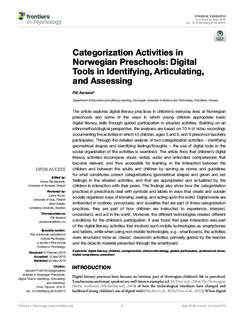| dc.description.abstract | The article explores digital literacy practices in children’s everyday lives at Norwegian preschools and some of the ways in which young children appropriate basic digital literacy skills through guided participation in situated activities. Building on an ethnomethodological perspective, the analyses are based on 70 h of video recordings documenting the activities in which 45 children, aged 5 and 6, and 8 preschool teachers participated. Through the detailed analysis of two categorization activities – identifying geometrical shapes and identifying feelings/thoughts – the use of digital tools in the social organization of the activities is examined. The article finds that children’s digital literacy activities encompass visual, verbal, audio and embodied competencies that become relevant, and thus accessible for learning, in the interaction between the children and between the adults and children by serving as norms and guidelines for what constitutes correct categorizations (geometrical shapes and green and red feelings) in the situated activities, and that are appropriated and actualized by the children in interaction with their peers. The findings also show how the categorization practices in preschools deal with symbols and labels in ways that create and sustain socially organized ways of knowing, seeing, and acting upon the world. Digital media are embedded in routines, procedures, and socialites that are part of these categorization practices; they are part of how children are instructed to experience, interpret, understand, and act in the world. Moreover, the different technologies created different conditions for the children’s participation. It was found that peer interaction was part of the digital literacy activities that involved such mobile technologies as smartphones and tablets, while when using non-mobile technologies, e.g., smartboards, the activities were structured more as ‘classic’ classroom activities, primarily guided by the teacher and the didactic material presented through the smartboard. | nb_NO |

